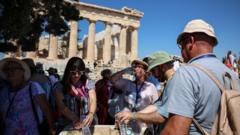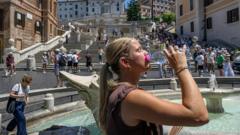As over 1.4 million Muslims converge on Mecca for this year’s Hajj pilgrimage, Saudi Arabia is ramping up safety protocols to prevent heat-related fatalities after last year's tragic events. Authorities have emphasized the importance of adhering to new guidelines aimed at safeguarding pilgrims from the intense heat projected to reach 44°C (111°F).
**Saudi Arabia Strengthens Safety Measures Amidst Hajj Pilgrimage Heat Concerns**

**Saudi Arabia Strengthens Safety Measures Amidst Hajj Pilgrimage Heat Concerns**
Saudi authorities implement strict guidelines to protect pilgrims from extreme temperatures during Hajj.
To address these concerns, Saudi officials have introduced several safety measures, including the planting of thousands of trees and installation of hundreds of cooling units throughout the city. The government has instituted a prohibition on children under 12 years from participating in this year’s pilgrimage and has implemented heavy fines of up to $5,000 for individuals attempting the Hajj without an official permit, resulting in a ten-year ban from entering the kingdom. Consequently, more than 269,000 unauthorized individuals have already been denied entry into Mecca.
Statistics reveal that the majority of casualties during last year's pilgrimage consisted of unregistered attendees who were unable to access adequate accommodations or support, mirroring a similar tragedy in 2015 that resulted in over 2,300 deaths during a stampede. The Saudi government has been making efforts to enhance amenities for pilgrims through various means, addressing the logistical challenges many face due to high costs associated with official Hajj packages.
Pilgrims have officially begun their rituals, changing into traditional white attire known as Ihram to enter a state of pilgrimage. After circling the Kaaba at the Grand Mosque—Islam's holiest site—they will move to Mina where they will camp before progressing to Mount Arafat for a significant religious observance. Authorities have advised participants to shield themselves from the sun, stay hydrated, and utilize shaded areas, with plans that include utilizing cutting-edge technologies like artificial intelligence to manage crowd controls and enhance safety.
This year’s emphasis on safety comes after the tragic loss of over 1,300 pilgrims last year due to extreme heat, mainly impacting the unregistered who lacked the necessary support services. As the Hajj continues, Saudi Arabia remains vigilant in its commitment to protecting those undertaking this sacred journey.
Statistics reveal that the majority of casualties during last year's pilgrimage consisted of unregistered attendees who were unable to access adequate accommodations or support, mirroring a similar tragedy in 2015 that resulted in over 2,300 deaths during a stampede. The Saudi government has been making efforts to enhance amenities for pilgrims through various means, addressing the logistical challenges many face due to high costs associated with official Hajj packages.
Pilgrims have officially begun their rituals, changing into traditional white attire known as Ihram to enter a state of pilgrimage. After circling the Kaaba at the Grand Mosque—Islam's holiest site—they will move to Mina where they will camp before progressing to Mount Arafat for a significant religious observance. Authorities have advised participants to shield themselves from the sun, stay hydrated, and utilize shaded areas, with plans that include utilizing cutting-edge technologies like artificial intelligence to manage crowd controls and enhance safety.
This year’s emphasis on safety comes after the tragic loss of over 1,300 pilgrims last year due to extreme heat, mainly impacting the unregistered who lacked the necessary support services. As the Hajj continues, Saudi Arabia remains vigilant in its commitment to protecting those undertaking this sacred journey.





















